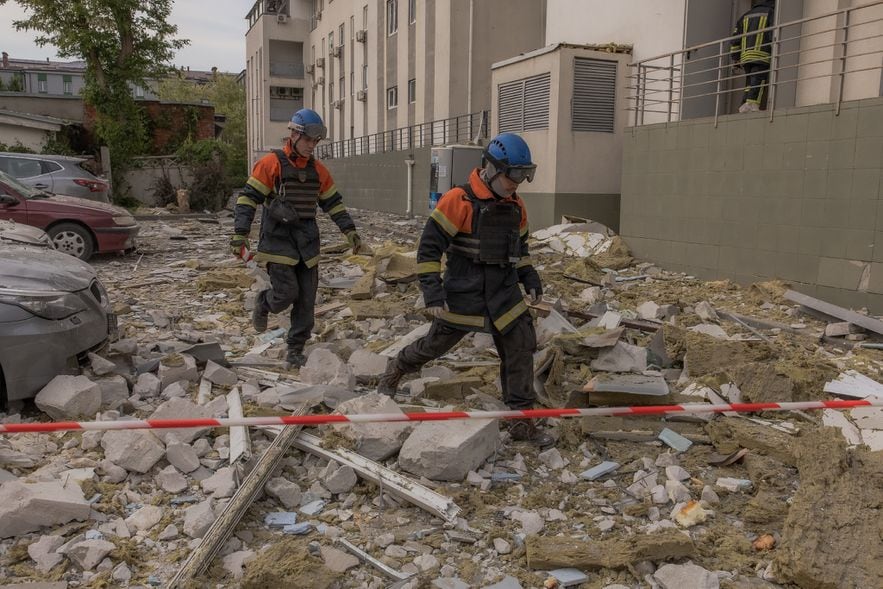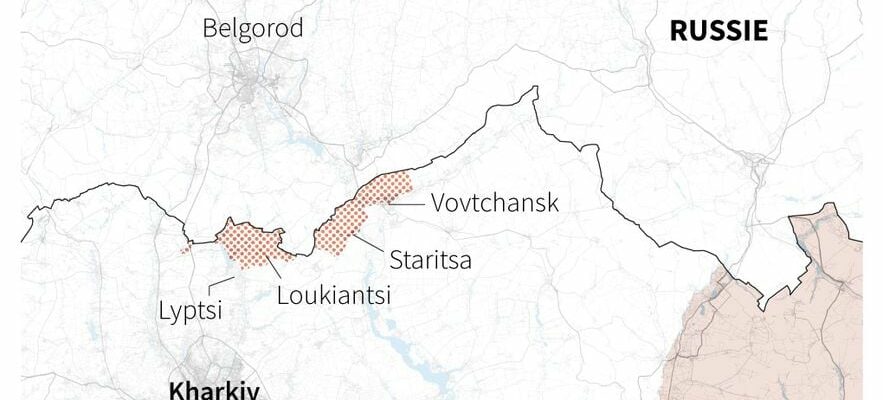In the small town of Vovchansk, some 5 kilometers from the Russian border, in northern Ukraine, the thick smoke from bombings once again obscures the horizon. Captured for the first time by Moscow’s troops on the first day of their invasion in February 2022, before being liberated by Ukrainian forces six months later, this modest city of around 20,000 inhabitants is one of the many localities targeted by the new Russian offensive launched on May 10 in the Kharkiv region.
“Since the beginning of the year, our troops have been improving their positions every day in all directions. They are meeting all the objectives set by the Ministry of Defense,” Vladimir Putin boasted five days later, reaffirming his “confidence ” in the continuation of operations.
After months of facing an ammunition shortage, the situation on the front has become critical for the Ukrainian army. “The interruption of American arms deliveries worked in favor of the Russians, recalls Mykhailo Gonchar, president of the Ukrainian institute Center for Global Studies Strategy XXI. Even if they resumed today, the lost time opened up a window for them. window of opportunity.”
The arrival of good weather also facilitates the resumption of major land maneuvers. In less than a week, Russian forces have conquered more than 200 square kilometers in the Kharkiv region, their most significant territorial gains since the start of the year, causing growing concern behind the scenes within Western chancelleries.
Kharkiv within artillery range
For the moment, around 50,000 Russian soldiers are present in the northern sector, including 30,000 directly involved in the fighting. In addition to Vovchansk, Russia launched another axis of attack in the Lukiantsi sector, about thirty kilometers north of the city of Kharkiv – second largest in Ukraine with 1.4 million inhabitants and capital of the oblast of the same name. “The troops engaged in the area currently appear insufficient to hope to take such an agglomeration, but they could succeed in approaching it,” assesses General (2S) Jérôme Pellistrandi, editor-in-chief of the National Defense Magazine.
Map of the Russian advance into northern Ukraine
© / AFP
The main Ukrainian defense lines still stand in their way, located around fifteen kilometers from the border, according to kyiv. Following a meeting at NATO headquarters in Brussels on May 16, the supreme commander of the Allied Forces in Europe, American General Christopher Cavoli, estimated that the Russians currently had “neither the skills nor capabilities” to achieve a major “breakthrough” in the region.
The opening of a new front is no less strategic for the Russian general staff. As early as mid-March, Moscow had discussed the creation of a “buffer zone” near the border, in order to prevent the Ukrainian army from striking its neighboring territory of Belgorod. The interest of the maneuver is not only defensive. “It’s a pretext,” says Mikhailo Gonchar. “Especially since our armed forces have the capacity to launch drone attacks several hundred kilometers away. Conversely, this buffer zone would allow Russia to put the city of Kharkiv within range of its artillery and multiple rocket launcher systems.”
Weaken the Eastern Front
Enough to further strengthen the threat weighing on this metropolis already regularly targeted by Russian drones and missiles, which Moscow had tried to capture – without success – in 2022. And at the same time, increase the pressure on the civilian population. In one week, more than 8,800 people have already fled the fighting in the north. A sign of the severity of the situation, Volodymyr Zelensky traveled to the region on May 16, deeming the situation there “extremely difficult” but “under control”.

Rescuers in Kharkiv, northeastern Ukraine, after a Russian missile strike, May 14, 2024
© / afp.com/Roman PILIPEY
More generally, the opening of a second front in the north could destabilize Ukrainian defense in the east of the country, where Moscow has tirelessly continued its offensive efforts since the capture of Avdiivka in mid-February. “The Ukrainians cannot afford to leave Kharkiv unprotected,” notes General Pellistrandi. “Which implies sending significant forces there which will be taken from the rest of the front.” A way of imposing a strategic dilemma on the Ukrainian command, forced to put out multiple fires with limited resources in terms of both men and ammunition.
On the eastern front, the small fortified town of Tchassiv Iar, about ten kilometers west of Bakhmut, is in Moscow’s sights. Held hard by the Ukrainians for months, this bastion constitutes a necessary crossing point before any offensive towards Kramatorsk – the regional administrative capital which Moscow wants to get its hands on to complete its control of the Donetsk oblast. “Faced with the difficulties they encountered there, the Russians concluded that they had to open a second front in the north to push the Ukrainian army to weaken its defenses in the east,” summarizes Mikhailo Gonchar.
This maneuver may not be the last of its kind. According to the head of Ukrainian military intelligence Kyrylo Budanov, the Russian army is also amassing forces near the border region of Sumy, in the northwest of the Kharkiv oblast. Augmenting the possible opening of a new front in the coming weeks.
.
